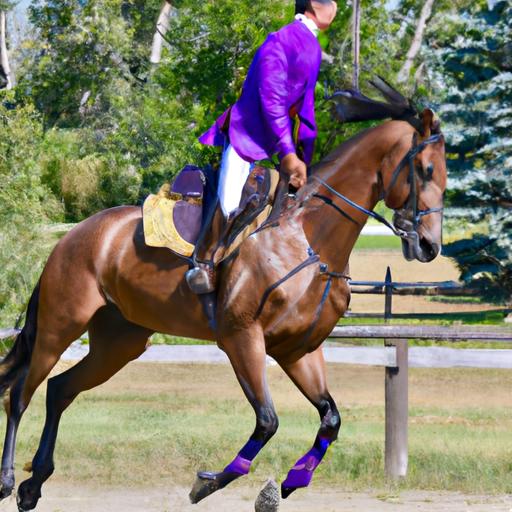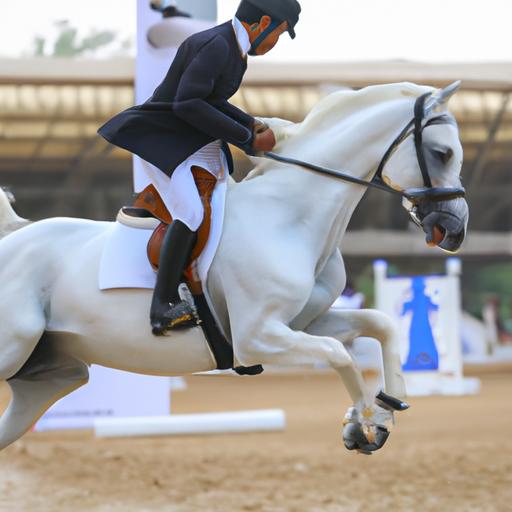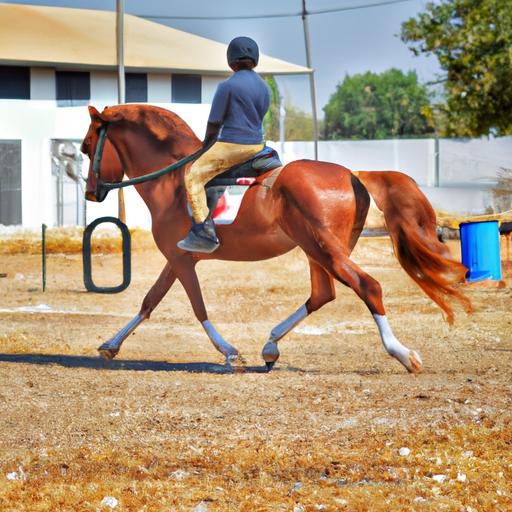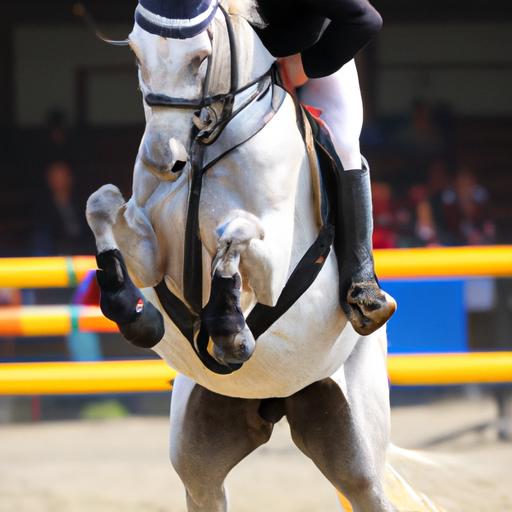Discover the art of standing on horse sport – a captivating discipline that demands balance, skill, and precision. Unleash your equestrian prowess today!
Introduction

Have you ever wondered what it takes to achieve true harmony between horse and rider? Standing on horse sport is a captivating discipline that pushes the boundaries of equestrianism, demanding exceptional balance, skill, and precision. In this article, we will delve into the world of standing on horse sport, exploring its definition, overview, as well as its intriguing historical background and evolution.
Definition and Overview of the Sport
Standing on horse sport, also known as standing riding or stilt riding, is an extraordinary equestrian discipline where riders remain standing on the backs of horses while they are in motion. This awe-inspiring sport requires a profound connection and trust between the rider and the horse, as they synchronize their movements to maintain stability and grace.
Historical Background and Evolution of Standing on Horse Sport
Dating back centuries, standing on horse sport has roots in various cultures around the world. From ancient Mongolian horseback archers to the daring Cossack stunt riders, this art form has transcended time and geography. Historically, it was predominantly utilized for military purposes and entertainment, showcasing the exceptional horsemanship skills of warriors and performers.
As the sport evolved, it gained recognition beyond its traditional roots, captivating audiences with its breathtaking displays of balance and control. Today, standing on horse sport combines elements of artistry, athleticism, and horsemanship, enchanting spectators and inspiring riders to push the boundaries of their abilities.
Now, let’s dive deeper into the benefits of standing on horse sport in Section 2.
Benefits of Standing on Horse Sport

Physical Benefits for Riders
When it comes to physical fitness, standing on horse sport offers a multitude of advantages that go beyond the ordinary. By engaging in this unique discipline, riders can experience a remarkable transformation in their physical abilities.
1. Improved Balance and Coordination
Maintaining balance while standing on a moving horse challenges riders to develop exceptional proprioceptive skills. As they learn to adjust their body positions and distribute their weight effectively, their balance and coordination are greatly enhanced. This newfound stability not only benefits their performance in standing on horse sport but also carries over to other areas of their daily lives.
2. Strengthening of Core Muscles
Standing on horseback engages the core muscles to a remarkable extent. The constant adjustments and micro-movements required to maintain stability activate the abdominal, back, and pelvic muscles, leading to increased strength and endurance. By regularly practicing this sport, riders can develop a strong and stable core, which improves their overall posture and body control.
3. Increased Flexibility and Agility
The dynamic nature of standing on horse sport demands flexibility and agility from riders. Regular training and stretching exercises can significantly improve the range of motion in joints and muscles. As riders become more flexible, they can execute intricate movements with ease, enhancing their overall performance and gracefulness on horseback.
Mental Benefits for Riders
Beyond the physical aspects, standing on horse sport also offers a plethora of mental benefits that contribute to personal growth and well-being.
1. Enhanced Focus and Concentration
Mastering the art of standing on horseback requires unwavering focus and concentration. Riders must remain fully present, attuned to their horse’s movements and their own body positioning. This intense mental focus spills over into other areas of life, improving concentration, and sharpening cognitive abilities.
2. Boost in Self-Confidence and Discipline
As riders progress in standing on horse sport, their confidence soars. The ability to conquer fears, maintain balance, and execute intricate maneuvers instills a sense of accomplishment and self-belief. Additionally, the discipline required to master this sport translates into discipline in other aspects of life, fostering personal growth and success.
3. Stress-Relief and Relaxation
The rhythmic motion of the horse, coupled with the meditative state of mind required for standing on horse sport, creates a serene and calming experience. Riding becomes a form of therapy, allowing riders to escape from the stresses of daily life and find solace in the connection between horse and rider.
With numerous physical and mental benefits, standing on horse sport offers a holistic approach to personal development. In the next section, we will explore the essential equipment and gear required for this captivating discipline.
Equipment and Gear for Standing on Horse Sport

When it comes to standing on horse sport, having the right equipment and gear is essential for both the rider’s safety and performance. Let’s explore the key elements that make up a well-equipped standing on horse rider.
Proper Footwear
One of the most crucial aspects of standing on horse sport is having suitable footwear. Riders should opt for flat-soled, well-fitting boots that provide excellent grip and support. The right footwear ensures stability and helps maintain balance while standing on the horse’s back.
Safety Gear and Protective Equipment
Safety should always be a top priority in any equestrian discipline, and standing on horse sport is no exception. Riders must wear a properly fitted helmet to protect the head from potential falls or accidents. Additionally, wearing protective gear such as knee and elbow pads can reduce the risk of injuries during training or performances.
Specialized Saddles and Stirrups
To achieve optimal balance and control while standing on a horse’s back, specialized saddles and stirrups are crucial. These are designed to provide the necessary stability and support, allowing riders to maintain their position securely. The saddles used in standing on horse sport typically have a flatter seat and a higher pommel to aid in balance.
Additional Accessories for Enhanced Performance
For riders aiming to take their standing on horse sport to the next level, certain accessories can enhance their performance. Grip pads or sticky sprays can be applied to the horse’s back to provide additional traction, ensuring a secure foothold for the rider. Additionally, using reins with a non-slip grip can help maintain control and stability during maneuvers.
By investing in the right equipment and gear, riders can enhance their safety, comfort, and overall performance in standing on horse sport. Now, let’s move on to Section 4, where we will explore the techniques and training involved in mastering this captivating discipline.
Techniques and Training for Standing on Horse Sport
Basic Stance and Posture
Mastering the art of standing on horse sport begins with establishing a strong foundation through proper stance and posture. It is crucial to maintain an upright position, aligning your body with the horse’s movement. Keep your feet shoulder-width apart, knees slightly bent, and distribute your weight evenly. Engage your core muscles to achieve stability and maintain a relaxed yet alert upper body posture.
Balance Exercises and Drills
To enhance your balance and coordination, incorporating balance exercises and drills into your training regimen is essential. These exercises can include standing on a stability ball, practicing yoga poses on a horse simulator, or performing exercises on a balance board. By challenging your equilibrium in various ways, you will develop the necessary proprioception and muscle control required for standing on horse sport.
Progressive Training Routines
Progressively building your skills is key to becoming proficient in standing on horse sport. Start with shorter practice sessions and gradually increase the duration as you gain confidence and stability. Begin on a stationary horse simulator or with a calm and experienced horse, gradually transitioning to a moving horse. As you advance, incorporate lateral movements, circles, and transitions to further refine your technique and adaptability.
Tips for Improving Stability and Control
To improve your stability and control while standing on horseback, consider the following tips:
-
Focus on your breathing: Deep, rhythmic breathing helps relax your body and maintain focus, allowing you to better connect with your horse’s movements.
-
Visualize success: Envision yourself maintaining a balanced and poised position, building confidence and mental preparation for your rides.
-
Strengthen your core: Engage in off-horse exercises such as planks, squats, and Pilates to strengthen your core muscles, providing a solid foundation for your standing position.
-
Seek professional guidance: Working with a qualified instructor who specializes in standing on horse sport can provide valuable feedback, guidance, and personalized training plans to help you progress effectively.
By incorporating these techniques and training methods into your practice, you will steadily improve your stability, control, and overall performance in standing on horse sport.
Next, let’s explore the importance of safety measures and precautions in Section 5.
Safety Measures and Precautions in Standing on Horse Sport
As with any equestrian activity, safety should always be a top priority in standing on horse sport. Taking necessary precautions and following safety guidelines not only ensures a smooth and enjoyable experience but also minimizes the risk of injuries. Let’s explore some essential safety measures to consider when engaging in this thrilling sport.
Importance of Proper Warm-Up and Stretching
Before embarking on any riding session, it is crucial to warm up your body and stretch your muscles. This helps prepare your body for the physical demands of standing on horseback, reducing the likelihood of strains or sprains. Engage in dynamic warm-up exercises, such as light jogging or leg swings, to increase blood flow and loosen up your muscles. Additionally, perform stretching exercises targeting the lower back, hips, and legs to enhance flexibility.
Guidelines for Selecting a Suitable Horse
Choosing the right horse is paramount in ensuring a safe and successful standing on horse sport experience. Consider the horse’s temperament, training, and suitability for the sport. Opt for a horse that is calm, responsive, and well-trained in carrying riders in a standing position. Consult with experienced trainers or instructors who can assess the compatibility between you and the horse, taking into account your skill level and experience.
Riding in Controlled Environments
To mitigate potential risks, it is advisable to practice standing on horse sport in controlled environments. Begin in enclosed arenas or fenced areas where there are minimal distractions and hazards. This allows you to focus on maintaining your balance and refining your skills without external factors causing unnecessary stress or accidents. As you progress, gradually introduce new environments, such as outdoor arenas or open fields, always prioritizing safety.
Emergency Procedures and First Aid Knowledge
Accidents can happen, even with proper precautions in place. Being prepared for emergencies and having a basic understanding of first aid is essential. Familiarize yourself with emergency dismount techniques and practice them regularly. Additionally, consider obtaining first aid certification or attending courses that specifically address equestrian-related injuries. This knowledge equips you to respond swiftly and appropriately in case of accidents, ensuring the well-being of both you and your horse.
By following these safety measures and precautions, you can enjoy the exhilaration of standing on horse sport while minimizing the potential risks involved. Now, let’s move on to Section 6, where we explore the world of competitions and events in this captivating discipline.


